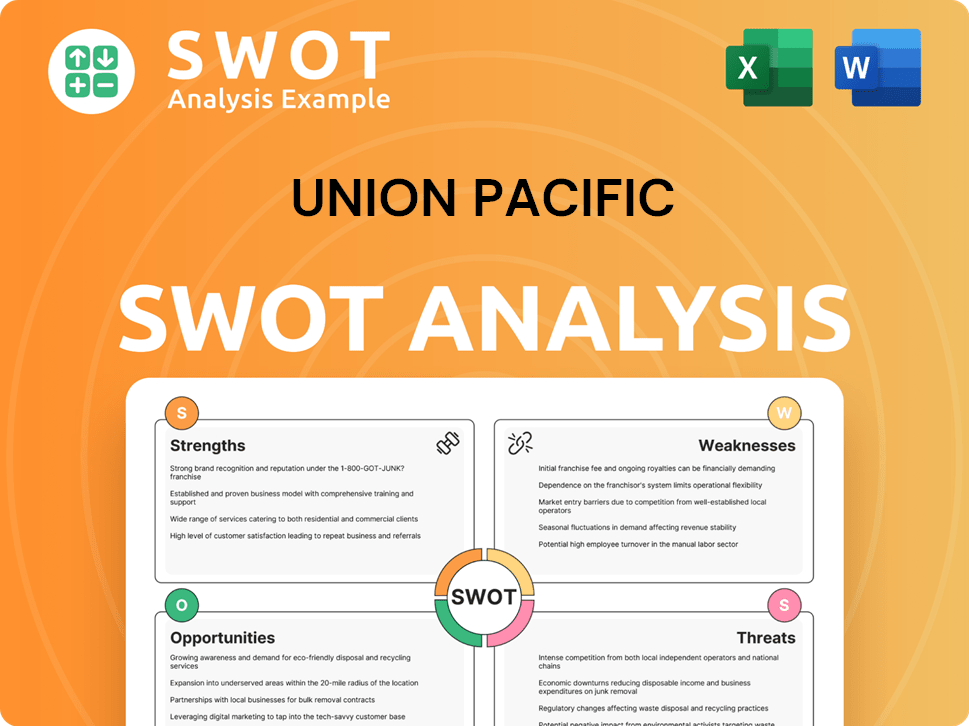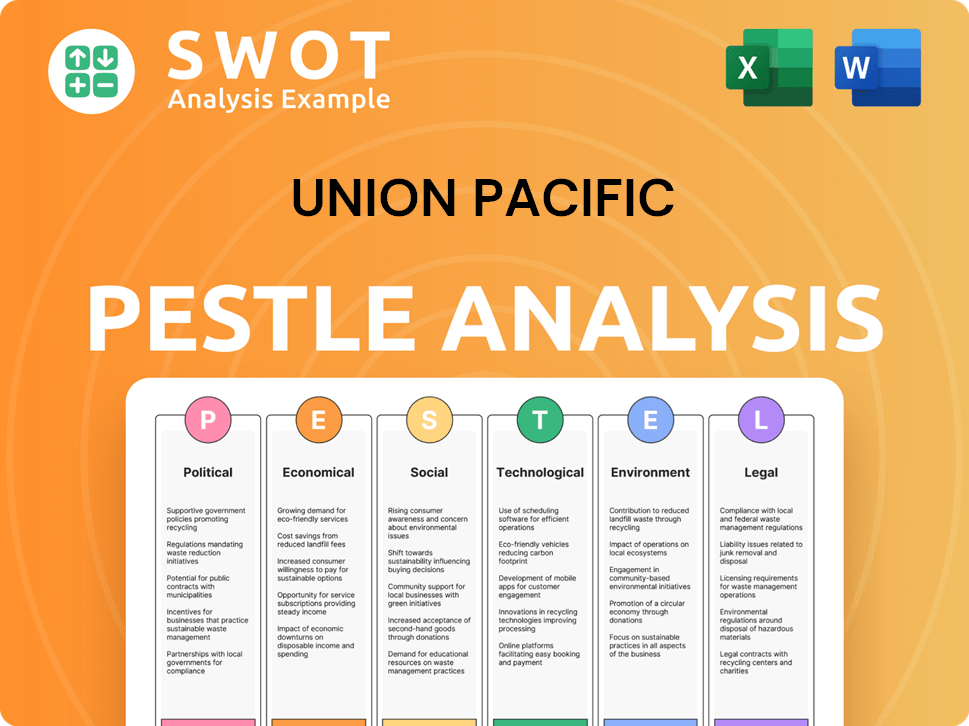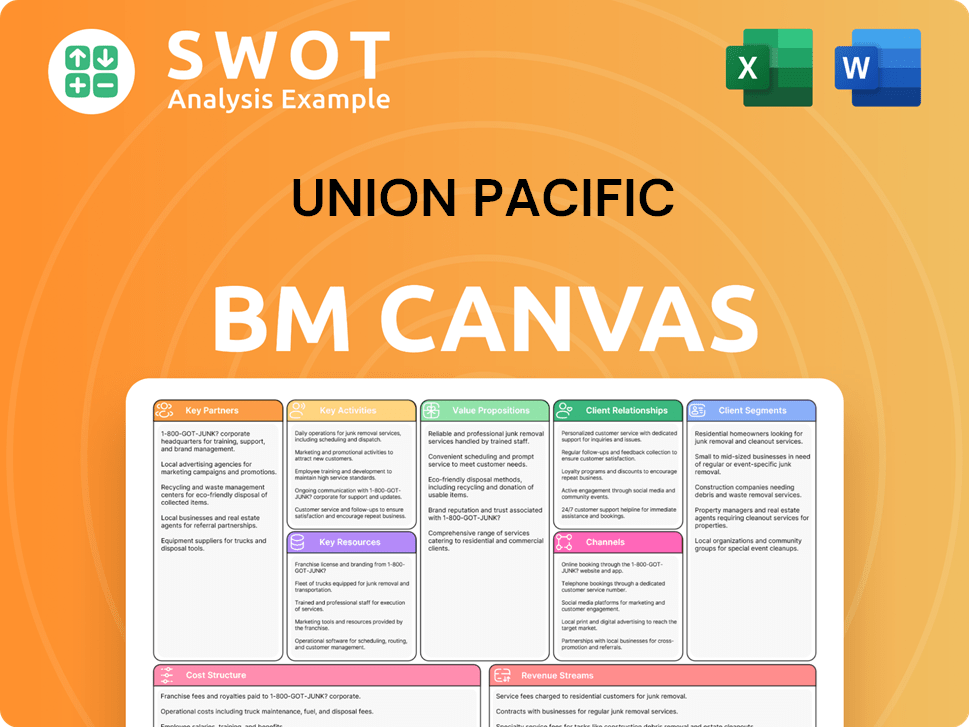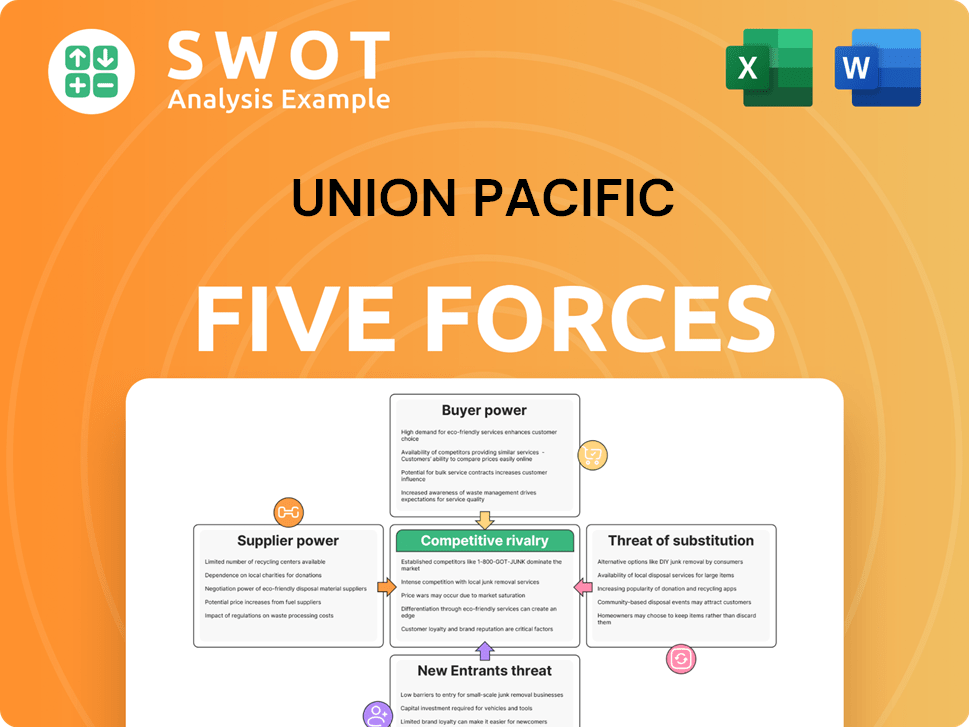Union Pacific Bundle
Can Union Pacific Maintain Its Momentum in the Evolving Freight Landscape?
From its inception in 1862, Union Pacific has been a cornerstone of American infrastructure, evolving from a pioneering railroad to a freight transportation giant. Today, it navigates a complex market, demanding a robust Union Pacific SWOT Analysis to understand its position. This exploration examines the company's strategic roadmap and future outlook.

Understanding the Union Pacific Growth Strategy is crucial for investors and analysts alike, as the company's performance is closely tied to Railroad Industry Trends and the overall health of the economy. This analysis will dissect UP Company Analysis, providing insights into its UP Financial Performance, expansion plans, and technological advancements, offering a comprehensive view of its Freight Transportation Market position and its potential for long-term success. We will delve into how Union Pacific plans to increase market share and its commitment to Union Pacific's sustainability efforts.
How Is Union Pacific Expanding Its Reach?
Union Pacific's growth strategy centers on expanding its network and service offerings, aiming to capture a larger share of the freight transportation market and adapt to evolving customer needs. This involves strategic investments in infrastructure, intermodal capacity, and industrial development. These initiatives are designed to enhance operational efficiency, diversify revenue streams, and stay ahead of industry trends.
A key aspect of the UP Company Analysis reveals a focus on infrastructure upgrades. The company plans significant capital expenditures to maintain and expand its network. These investments are crucial for supporting safe operations, renewing assets, and accommodating customer growth. This proactive approach helps Union Pacific maintain its competitive advantage in the railroad industry.
The company is actively expanding its intermodal footprint. This includes adding new intermodal service products and enhancing transload sites. Furthermore, Union Pacific is investing in industrial parks to facilitate business growth. These initiatives are driven by a desire to access new customers and diversify revenue streams.
Union Pacific plans to invest $3.4 billion in capital expenditures in 2025. Nearly $2 billion will be allocated to upgrading and replacing infrastructure, including rail, ties, and ballasts. Approximately $0.6 billion is earmarked for locomotives and equipment. These investments are crucial for maintaining operational efficiency and supporting long-term growth.
Since 2022, Union Pacific has added 895,000 annual lift capacity to its intermodal terminals. The company aims to add capacity for an additional 250,000 lifts in the coming years. This expansion supports business development in high-growth areas such as Southern California, Phoenix, and Kansas City. This expansion is a key part of the company's strategy to increase market share.
Union Pacific is investing in industrial parks, such as Prime Pointe near Dallas, to facilitate business growth. These projects aim to attract new customers and diversify revenue streams. The company currently has over 200 active customer construction projects with an annual revenue potential of $1.6 billion.
- These initiatives are designed to access new customers.
- They also aim to diversify revenue streams.
- The company is responding to industry changes, particularly the decline in coal demand.
- These efforts support the company's long-term growth potential.
Union Pacific SWOT Analysis
- Complete SWOT Breakdown
- Fully Customizable
- Editable in Excel & Word
- Professional Formatting
- Investor-Ready Format

How Does Union Pacific Invest in Innovation?
Union Pacific (UP) is actively leveraging technology and innovation as a core element of its Union Pacific Growth Strategy. The company's focus is on enhancing safety, improving service, and achieving operational excellence. This approach is critical in the context of current Railroad Industry Trends, which emphasize efficiency and customer satisfaction.
The company's digital transformation, led by Chief Information Officer Rahul Jalali, involves replacing outdated systems with modern technologies. This strategic shift is designed to boost operational efficiency and create a more customer-centric approach. The goal is to simplify business processes and provide customers with greater control over their shipments.
UP is investing heavily in technologies to improve the customer experience. This includes developing a 'Customer Vision' platform for enhanced shipment visibility and real-time tracking. These improvements are crucial for maintaining a competitive edge in the Freight Transportation Market.
UP is replacing legacy systems with modern, scalable technologies. This includes the implementation of NetControl, a platform for rail car inventory, scheduling, and terminal management.
The company is developing a 'Customer Vision' platform for enhanced shipment visibility and real-time tracking. This focus on transparency and collaboration simplifies business processes.
UP is exploring generative AI, zero-trust cybersecurity, and the future of mobility. They are also testing hybrid electric locomotives as part of their sustainability initiatives.
The modernization efforts include the introduction of microservices and thousands of APIs. These advancements are designed to improve asset management and operational decision-making.
UP is actively testing hybrid electric locomotives as part of its sustainability initiatives. This aligns with the company's commitment to reducing its environmental impact.
UP is pursuing Federal Railroad Administration (FRA) waivers for autonomous track inspection systems. This demonstrates a commitment to safety and innovation.
These technological advancements contribute to UP's growth objectives by improving asset management, operational decision-making, and overall productivity. For example, in Q1 2025, the company reported a 6% improvement in freight car velocity and a 9% increase in workforce productivity. UP's commitment to innovation is evident in its pursuit of FRA waivers for autonomous track inspection systems, showcasing its dedication to safety and efficiency. These initiatives are critical for UP's UP Financial Performance and long-term success.
UP's technology strategy focuses on enhancing customer experience, improving operational efficiency, and embracing sustainability. These initiatives are designed to drive UP's Revenue Growth Drivers and increase market share.
- Development of the 'Customer Vision' platform for real-time tracking.
- Implementation of NetControl for rail car inventory and scheduling.
- Exploration of generative AI and zero-trust cybersecurity.
- Testing of hybrid electric locomotives.
- Pursuit of FRA waivers for autonomous track inspection systems.
Union Pacific PESTLE Analysis
- Covers All 6 PESTLE Categories
- No Research Needed – Save Hours of Work
- Built by Experts, Trusted by Consultants
- Instant Download, Ready to Use
- 100% Editable, Fully Customizable

What Is Union Pacific’s Growth Forecast?
The financial outlook for Union Pacific (UP) in 2025 is focused on maintaining operational efficiency and achieving solid earnings per share (EPS) growth. The company is aligning its strategies with long-term objectives, targeting high single to low double-digit growth. This is supported by strategic capital expenditures and a strong commitment to returning value to shareholders through share repurchases.
In the first quarter of 2025, Union Pacific reported a net income of $1.6 billion, or $2.70 per diluted share, which was consistent with the same period in 2024. While total operating revenue remained flat at $6.03 billion, the company experienced a 7% volume growth and saw solid core pricing gains. Factors such as business mix, reduced fuel surcharge revenue, and the impact of the leap year influenced these results.
Union Pacific's strategic financial planning for 2025 includes capital expenditures of $3.4 billion, similar to its 2024 program. This investment is intended to maintain operational efficiency and support future growth. Additionally, the company plans to repurchase between $4.0 billion and $4.5 billion in shares in 2025, reflecting its commitment to shareholder value. For more insights into the company's target market, you can read the article: Target Market of Union Pacific.
Net income for Q1 2025 was $1.6 billion, with earnings per diluted share at $2.70. Total operating revenue remained flat at $6.03 billion, despite volume growth. The operating ratio was 60.7%, indicating operational efficiency.
Union Pacific plans to invest $3.4 billion in capital expenditures in 2025. These investments are focused on maintaining and improving operational efficiency. This is consistent with the 2024 capital program.
The company intends to repurchase between $4.0 billion and $4.5 billion in shares in 2025. This reflects a strong commitment to returning value to shareholders. This is a key component of the UP Growth Strategy.
The operating ratio for Q1 2025 was 60.7%, flat compared to 2024. For the full year 2024, net income was $6.7 billion, or $11.09 per diluted share. The 2024 operating ratio was 59.9%.
Analysts forecast an average price of $222.07 for Union Pacific stock (UNP) in 2025. This forecast reflects the anticipated performance of the company. The forecast is based on the analysis of the company's financial performance.
- The forecast is based on various factors, including the company's financial performance.
- External factors, such as industry trends and economic conditions, also influence the stock forecast.
- The forecast provides investors with an estimate of the potential value of the stock.
- Investors should consider the forecast as part of their overall investment strategy.
Union Pacific Business Model Canvas
- Complete 9-Block Business Model Canvas
- Effortlessly Communicate Your Business Strategy
- Investor-Ready BMC Format
- 100% Editable and Customizable
- Clear and Structured Layout

What Risks Could Slow Union Pacific’s Growth?
The future prospects of Union Pacific (UP) are subject to various risks and obstacles. These challenges span market dynamics, economic conditions, regulatory changes, and internal operational factors. Understanding these potential pitfalls is crucial for evaluating the Union Pacific Growth Strategy and its long-term viability.
Market competition and economic shifts pose ongoing challenges. The company anticipates that volume in 2025 will be impacted by a mixed economic backdrop, coal demand, and challenging year-over-year international intermodal comparisons. Additionally, factors like fuel price fluctuations, supply chain vulnerabilities, and labor negotiations add to the complexity.
The railroad industry is capital-intensive, requiring significant investments. Union Pacific plans a $3.4 billion capital expenditure for 2025. Furthermore, changes in consumer spending due to interest rate fluctuations are closely monitored. All these factors can influence the UP Financial Performance.
Weak market demand and heightened competition may lead to price wars, affecting profit margins. Potential tariff changes and other regulatory shifts can impact market segments. The Freight Transportation Market is sensitive to these external factors.
Fluctuations in fuel prices and supply chain disruptions present challenges to cost control. The company must manage internal resource constraints, including labor negotiations. Interest rate fluctuations could influence consumer spending, affecting the company's financial results.
Changes in regulations and trade policies, such as potential tariff adjustments, can significantly impact market segments and overall volumes. These factors can create uncertainty and affect the Union Pacific Future Prospects.
The railroad industry's capital-intensive nature requires substantial investments to maintain and upgrade the network. Union Pacific's planned $3.4 billion capital expenditure for 2025 demonstrates its commitment to infrastructure.
Ongoing labor negotiations and internal resource limitations pose operational challenges. These constraints can affect efficiency and service delivery, impacting the company's ability to meet market demands.
Economic conditions, including interest rate fluctuations, can influence consumer spending and, consequently, the demand for freight services. The company must remain adaptable to navigate these changing economic landscapes.
Union Pacific addresses these risks through strategic initiatives focused on safety, service, and operational excellence. Management prioritizes preparedness for market volatility and a commitment to operational efficiency. The company's improved workforce productivity, which increased by 9% in Q1 2025, reflects these efforts.
Understanding Railroad Industry Trends is critical for assessing the company's position. Factors like technological advancements, sustainability efforts, and evolving customer demands shape the industry's future. The company is actively working on Union Pacific's strategic initiatives 2024.
Union Pacific Porter's Five Forces Analysis
- Covers All 5 Competitive Forces in Detail
- Structured for Consultants, Students, and Founders
- 100% Editable in Microsoft Word & Excel
- Instant Digital Download – Use Immediately
- Compatible with Mac & PC – Fully Unlocked

Related Blogs
- What are Mission Vision & Core Values of Union Pacific Company?
- What is Competitive Landscape of Union Pacific Company?
- How Does Union Pacific Company Work?
- What is Sales and Marketing Strategy of Union Pacific Company?
- What is Brief History of Union Pacific Company?
- Who Owns Union Pacific Company?
- What is Customer Demographics and Target Market of Union Pacific Company?
Disclaimer
All information, articles, and product details provided on this website are for general informational and educational purposes only. We do not claim any ownership over, nor do we intend to infringe upon, any trademarks, copyrights, logos, brand names, or other intellectual property mentioned or depicted on this site. Such intellectual property remains the property of its respective owners, and any references here are made solely for identification or informational purposes, without implying any affiliation, endorsement, or partnership.
We make no representations or warranties, express or implied, regarding the accuracy, completeness, or suitability of any content or products presented. Nothing on this website should be construed as legal, tax, investment, financial, medical, or other professional advice. In addition, no part of this site—including articles or product references—constitutes a solicitation, recommendation, endorsement, advertisement, or offer to buy or sell any securities, franchises, or other financial instruments, particularly in jurisdictions where such activity would be unlawful.
All content is of a general nature and may not address the specific circumstances of any individual or entity. It is not a substitute for professional advice or services. Any actions you take based on the information provided here are strictly at your own risk. You accept full responsibility for any decisions or outcomes arising from your use of this website and agree to release us from any liability in connection with your use of, or reliance upon, the content or products found herein.